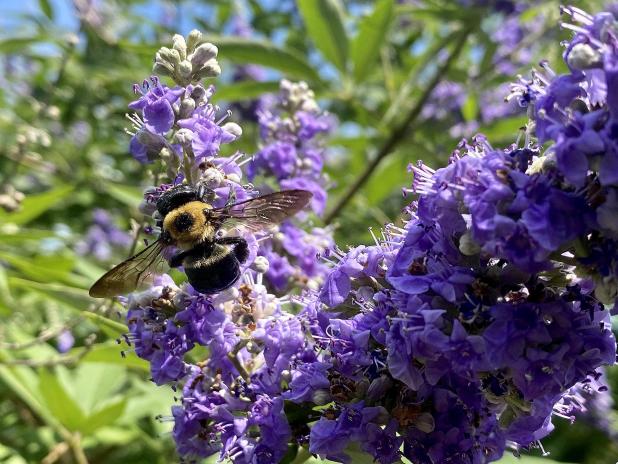
Chaste trees produce showy 5- to 7-inch spikes of small lavender blue flowers from late May through June in Louisiana with a second flush of flowers again in July or early August. Shoal Creek a Louisiana Super Plant.
—LSU AgCenter/Heather Kirk-Ballard
Get It Growing: Chaste tree is great landscape plant
The Oxford English Dictionary defines the word chaste as without unnecessary ornamentation; simple or restrained. Chaste tree, also known as vitex, is simple in ease of care but is far from being plain.
The plant’s name finds its origin in a Roman book titled “Naturalis Historia.” The author noted that women in Athens kept branches of the tree under their beds during the feast of Ceres, the Roman goddess of agriculture, grain and fertility.
Vitex can be found in bloom all across the state this time of year. These large, deciduous flowering shrubs are often considered a small tree for landscapes. They put on a show from late spring through summer with their beautiful bluish-purple flowers clustered in tall spikes. These trees bloom every year in their season with minimal effort on the gardener’s part for about a month.
Chaste trees produce showy 5- to 7-inch spikes of small lavender blue flowers from late May through June in Louisiana, with a second flush of flowers again in July or early August.
But that isn’t the only color they come in. Other cultivars offering white flowers include Alba and Silver Spire and pink flowers such as Rosea. One of the most favored cultivars is Shoal Creek a Louisiana Super Plant selection. And then Purpurea has lighter purple flowers.
Vitex trees should be planted in full sun for the best blooms, but they also do well in partial shade. Plants grow to 10 to 15 feet tall by 15 to 20 feet wide. Its growth rate is vigorous in loose, well-drained soil that is a bit on the dry side. In fact, it’s very drought-tolerant once established. In wet soils, the chaste tree can suffer from dieback and root rot and occasionally get leaf spot. But it has no major pest concerns.
Allowed to grow naturally, vitex will generally form a large, bushy plant about 10 feet tall. If you want it in a more compact form, you can cut the plant back to about 2 to 3 feet from the ground in late winter.
In addition to their beautiful flowers, vitex have attractive, star-shaped, aromatic leaves. When you brush against or crush the leaves, the scent is a crisp and clean, similar to a sage.
The leaves are green-gray on top and gray underneath and grow in a palmate pattern with five to seven lance-shaped leaflets emanating from a single point.
Vitex make an excellent focal planting for the landscape. And when they bloom, they not only catch the eye of the beholder; the pollinators also love this tree. Bees, butterflies and hummingbirds can all be seen feeding on their sweet nectar. Additionally, the seeds attract several small bird species. This is an excellent selection for those keeping bees for honey.
Chaste trees are deciduous and may lose their leaves in extended cold snaps. However, they will not remain bare for long thanks to a fast growth rate. Harder freezes may result in some dieback and damage, but they will be back.
Chaste tree is a non-native species. Some people consider it invasive because the seeds may colonize nearby landscape beds and become weedy. However, if the old flower spikes are removed to prevent seeds from forming, you can help control the spread of the plant. You also can reproduce the plant by cuttings very easily.
I’d like to highlight Shoal Creek as an outstanding selection of vitex with superior characteristics compared to the standard. The 12-inch flower spikes are noticeably larger, deeper, more vibrant lavender-blue color. It has exceptionally vigorous growth, filling your landscape quickly with beautiful, aromatic leaf growth and gorgeous flower spikes.
If you prize plants that don’t require a lot of care but pack a beautiful punch, you can’t do better than chaste trees. Local nurseries and garden centers do a great job of carrying Louisiana Super Plants, so look for Shoal Creek vitex there.
To learn more about the Louisiana Super Plants program and find participating nurseries near you visit online at www.lsuagcenter.com/superplants.
